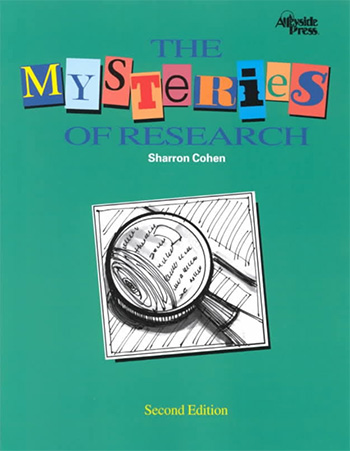Embracing Research - Identifying Reference Resources
Introduction | Background Knowledge | Activities | Extensions

Introduction
Before students can find information, they need to know where to look. Make sure that you have introduced basic resources to your students. Check that students know what they can use each resource for. Finally, and most importantly, determine the purpose of using each resource. Are you asking your students to use the resource because it is required for a standardized testing skill, or are you asking them to use the resource to locate information? This guide will focus on the latter.
These are the "big 5" reference materials that are available in most school libraries or classrooms. Consider your purpose before you spend your time teaching students to use an obsolete resource. Why are you having your students look their spelling words up in the dictionary? Are they listing five synonyms for "big" because you want them to find a word in the thesaurus or because they need to liven up their writing? Print reference materials take up space and collect dust. How can you meet your instructional goals and develop future-ready skills at the same time?
Background Knowledge

Dictionary
- The dictionary is a word reference resource. Students can use it to find definitions and parts of speech for a word. A dictionary will usually divide the word into syllables and provide the correct pronunciations of the word. This resource will also use the word in a sentence and provide synonyms. There are also subject-specific dictionaries aimed at students.
- A common expectation is that a dictionary will help a child find the appropriate spelling of a word. This practice is not the best use for a dictionary. It will only serve to show a child that their spelling is not correct. It will take a great deal of searching to find a word if a student does now know the correct spelling. An alternative is using dictionary apps for handheld devices and tablets; they often have a speech input where the user just says the word and the definition and other information is provided.
- If you are using a print dictionary, then the need for explicit instruction increases for younger students or students whose primary language is not English. Students will need to have an idea of where a letter falls in the alphabet and know to look at the beginning for A, but the middle for M, and near then end for W. Students will also need detailed instruction on guide words and how to use them.
- There are many digital dictionaries available to schools and students. The following is not an exhaustive list, but these resources have been reviewed by TeachersFirst.
- Check your library resources for databases. If your school has purchased access to World Book Online, you have access to a dictionary.
- Dictionary.com (TeachersFirst review)
- Illustrated Math Dictionary (TeachersFirst review)
- Dictionarist: A Talking Dictionary (TeachersFirst review)
- Merriam-Webster’s Learner Dictionary (TeachersFirst review)
Thesaurus
- The thesaurus is also a word reference resource. Use it to find synonyms and antonyms of words. A print thesaurus will typically be only a list of words. A digital thesaurus will provide more information and will easily allow students to cross-reference words to find the exact word they are looking for.
- As with the dictionary, students will need explicit instruction on how to use the features of this resource. Many technology-based productivity tools have a similar feature built-in. Microsoft Word shows a list of synonyms at the touch of a button. There is a Thesaurus add-on available for Google Docs. Consider your purpose for introducing the resource. If your purpose is to enhance their writing and provide a tool to find more specific language, consider using a tool with a thesaurus built in to limit distractions when writing.
- There are several resources online. Again, this is not an exhaustive list, but TeachersFirst has reviewed each one.
- The Color Thesaurus (TeachersFirst review)
- Thesaurus.com (This resource is reviewed in conjunction with Dictionary.com above)
- Big Huge Thesaurus (TeachersFirst review)
- Visual Thesaurus (TeachersFirst review)
Almanac
- The almanac is a book of facts and lists. It is published annually. Some almanacs publish general facts, others are subject-matter specific. This resource is best for students who are simply looking for information to pass back on.
- Students will need to know how to use an index with ease to be able to use a print almanac.
- Using an online resource requires that students know how to use search terms effectively.
- Many students read almanacs and do not realize it! The Guinness Book of World Records is a popular almanac.
- There are several subject-matter specific online almanacs. The following is not an exhaustive list.
- The 50 States (TeachersFirst review) (Use this for state research in upper elementary and middle school. The resource is an almanac because it is a collection of facts and lists about each state.)
- The Old Farmer's Almanac for Kids (This is not a searchable resource, but provides information about weather and animals.)
- The Old Farmer's Almanac
- The World Almanac for Kids is available as a purchased database. Check to see if it is available in your school district.
- Fact Monster Almanac (TeachersFirst review) (This online resource is the closest match to the print World Almanac for Kids that is in most school libraries.)
- Guinness World Records
Atlas
- An atlas is a book of maps. In most print atlases, each continent is shown, and then you can see a closer look by country or by region, depending on the scope. Use an atlas to find locations.
- Students will need to understand how to use an index to use a print atlas.
- There are a variety of online atlases available.
Encyclopedia
- The encyclopedia is the tried and true authority of information. Arranged in alphabetical order by subject, most information can be found, in article form, in the encyclopedia. A print encyclopedia is published annually, and information is contained in multiple volumes (housed by letter), with an index to aid students in their search. Most school libraries have a print encyclopedia that is outdated.
- In order to use a print encyclopedia, students must know how to use alphabetical order and guide words efficiently as well as how to use an index to find information.
- Most reliable online encyclopedias are provided by subscription service, and access is password protected. Check with your school district to see if you have access to World Book Online or Encyclopedia Britannica. Those are the two most popular in public schools
- Wikipedia is NOT a reliable resource. Because any registered user can change Wikipedia, there can be times where the information is inaccurate. Older students can be taught to use it as a starting point, but younger students are not ready to use Wikipedia appropriately.
- Most online encyclopedias are subject-matter specific. Use the TeachersFirst search feature to help find what you are looking for. By using the search feature, you can find reviewed digital encyclopedias such as the Ancient History Encyclopedia (TeachersFirst review) or the Encyclopedia of Virginia (TeachersFirst review), among many others to help you and your students pinpoint the best resource for your project.
Activities

Basic Reference Materials Knowledge
- Kahoot (TeachersFirst review) is a great online resource to use to assess if your students know when to use each reference resource. There are ready-made Kahoot quizzes. (A quick search on the Discover tab shows over 8,000 Kahoots that deal with this topic!) You will need a way to project the Kahoot screen and students will need to use a device to access the answer choices.
- If your students do not have access to technology, you can use your personal device and use Plickers (TeachersFirst review) for student responses. You can ask the same questions from Kahoot, and your students can answer using Plickers cards. The response data updates in real-time, and you can see what you need to review at a glance!
- Quizziz (TeachersFirst review) Similar to Kahoot in that there are ready-made quizzes available, teachers create or assign premade assessments, and Quizziz allows students to work at their own pace on their own devices. Results are updated in real-time and there is a results tab for data collection.
Dictionary Activities
- Dictionary Man - This activity can be digital or not! Students look up a word in the dictionary and find all of the parts listed in the dictionary entry. The information is presented as a person. This can be done in a digital format with Google Slides. Here is a link to The Book Bug Blog for an example.
- Dictionary Relay - Choose the elements of a dictionary entry that you would like your students to know. Prepare a relay page - see The Book Bug Blog for a great example. Give each team a word - it can be the same word or different words. Students run to a dictionary, one at a time, find the answer to one question, and run back to their teams. The next student follows the same steps. The first team to complete the relay questions correctly wins! This activity can also be done digitally with Google Forms. HERE is an example.
Encyclopedia Activities
- Encyclopedia Bingo - Use this activity with a print encyclopedia or a digital encyclopedia. It would be easiest with a digital encyclopedia. Provide students with bingo boards. Make them for free at Bingo Card Creator (TeachersFirst review). Add facts that can be found in an encyclopedia to each square. Students use the encyclopedia to find the information. (For example: An ostrich can run _____ miles per hour. The answer on the bingo card would be 43mph.)
- Main Idea and Supporting Details Activity - Students can choose a topic (or can be assigned a topic) and find it in the encyclopedia. (Complete this activity with a print or digital encyclopedia.) Students work individually or in small groups to read the article and determine the main idea and supporting details. Students can organize their thoughts with a graphic organizer like the Main Idea Table or the Give Me 5 Hand. To take it a step further, ReadWriteThink (TeachersFirst review) has a great activity about identifying facts. This activity can be adapted to include having students identify the topic or main idea on their own, identifying the facts that they read, and then verifying facts in the encyclopedia! The students can present their products on paper or digitally using Google Slides, Chatterpix, or a video production app.
Atlas Activities
- TeachersFirst has created ReadingTreks that map a story using Google Maps. Check them out here. OK2Ask has a recording of a workshop that teaches you how to create your own! ReadingTreks use GoogleMaps to track various aspects of a book or story, from the geographical background of the author and illustrator to mapping the settings of the story. There are ReadingTreks for a variety of age groups, so you can choose a piece of literature that fits your students or your curriculum. Students can locate the specific places using the atlas resources that you have in your school or use digital tools to create their own! Because the resource is map-based, it fits perfectly with a study of the atlas!
- Similar to ReadingTreks, GoogleLitTrips (TeachersFirst review) puts stories on the map! To use this resource, you will need to register and request access to individual titles. There are specific, detailed directions for how to access the resources on the website. Like ReadingTreks, your students can explore the given maps or create their own!
- This is my favorite activity for the Atlas! Read How to Make an Apple Pie and See the World or How to Make a Cherry Pie and See the USA, both by Marjorie Priceman. Each book takes the main character on an adventure to different places. As you read, the students can locate the place mentioned in the atlas and then find it on a blank map, either print or digital. The students can number the location and color it in. This activity also provides a great resource for retelling the story later!
Almanac Activities
- Task cards - (Here is a great resource that is more project-based that uses the Farmer’s Almanac.) Lead students on a scavenger hunt through the almanac. Make it digital using Google Forms or Kahoot or stay with a print version where students write the answers. Check out GooseChase (TeachersFirst review) to create an engaging scavenger hunt with your students! Assign them tasks, and they will earn points as a team and complete the tasks you assign without realizing that they are learning!
- Create a class almanac. Because it is a book of lists and facts, students can brainstorm topics and create an almanac to remember their year. In addition to an arts and crafts activity, there are great digital tools to create a class book including MyStorybook (TeachersFirst review), which is a great point and click tool that will be easy for younger students to use to create a book, and Book Creator (TeachersFirst review), allows students to create a book that can include a voiceover. Book Creator is still a point and click program, but will appeal to an older audience.
Extensions

Research needs to have a purpose. While students need to understand the basic structure of each reference material and how to use it, the end goal is to use these materials to locate information. Apart from a formal research project, the following extension activities will bring purpose to your reference materials study.
-
Mysteries of Research - While this is available in a book that you can buy, the premise behind it is simple. A crime has been committed. There are four suspects. Each has been interviewed, and students are given the suspects’ alibis and information. They use the reference materials to check the facts that the suspects provide. The suspect that has false information is guilty. This activity can be done digitally or with paper and pencil and can be adapted to be an extension of literature. (Spookley the Square Pumpkin and Miss Nelson is Missing are two great examples). You can find an example of the research organizer here.

- Mini Research Projects - Not all research projects need to take weeks. Give students a topic that integrates with the current curriculum. Ask them an open-ended question. Give a couple of choices for how to present the information, and then the students can get to work. An example for students studying state history: Research your state flag and learn why it looks the way that it does. Using what you learned and what you know about your state’s history, create a NEW state flag. What did you choose to include? Why is that important to your state? How does your state flag compare to the original?
- Student-created task cards - Have your students work in groups to create task cards/scavenger hunts for another group to complete. Require that all questions link to the current curriculum. (For example, if you are studying plants, then all questions should be about plants.) The students are using the materials to create the questions and find the answers and then complete another group’s products.

